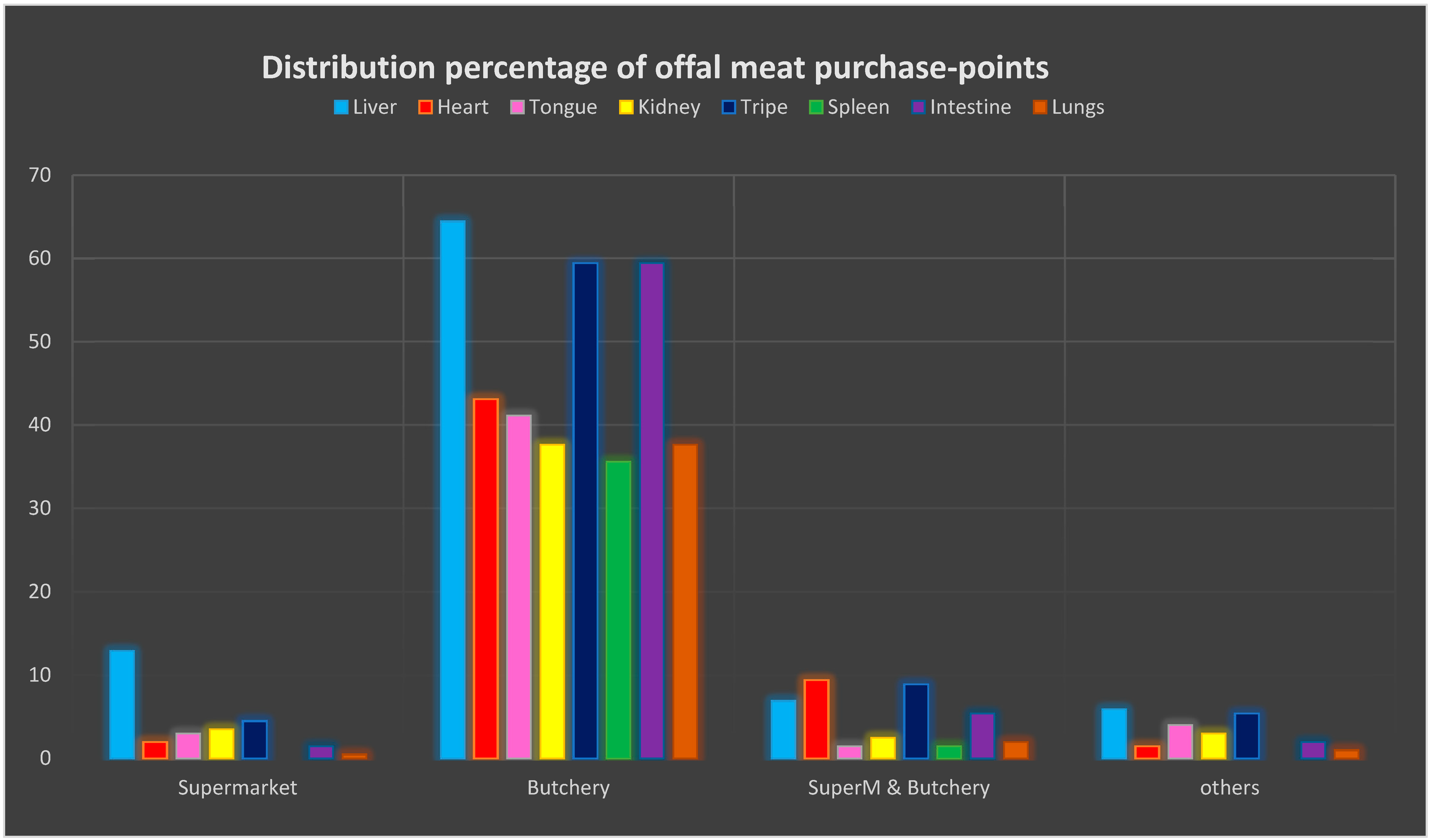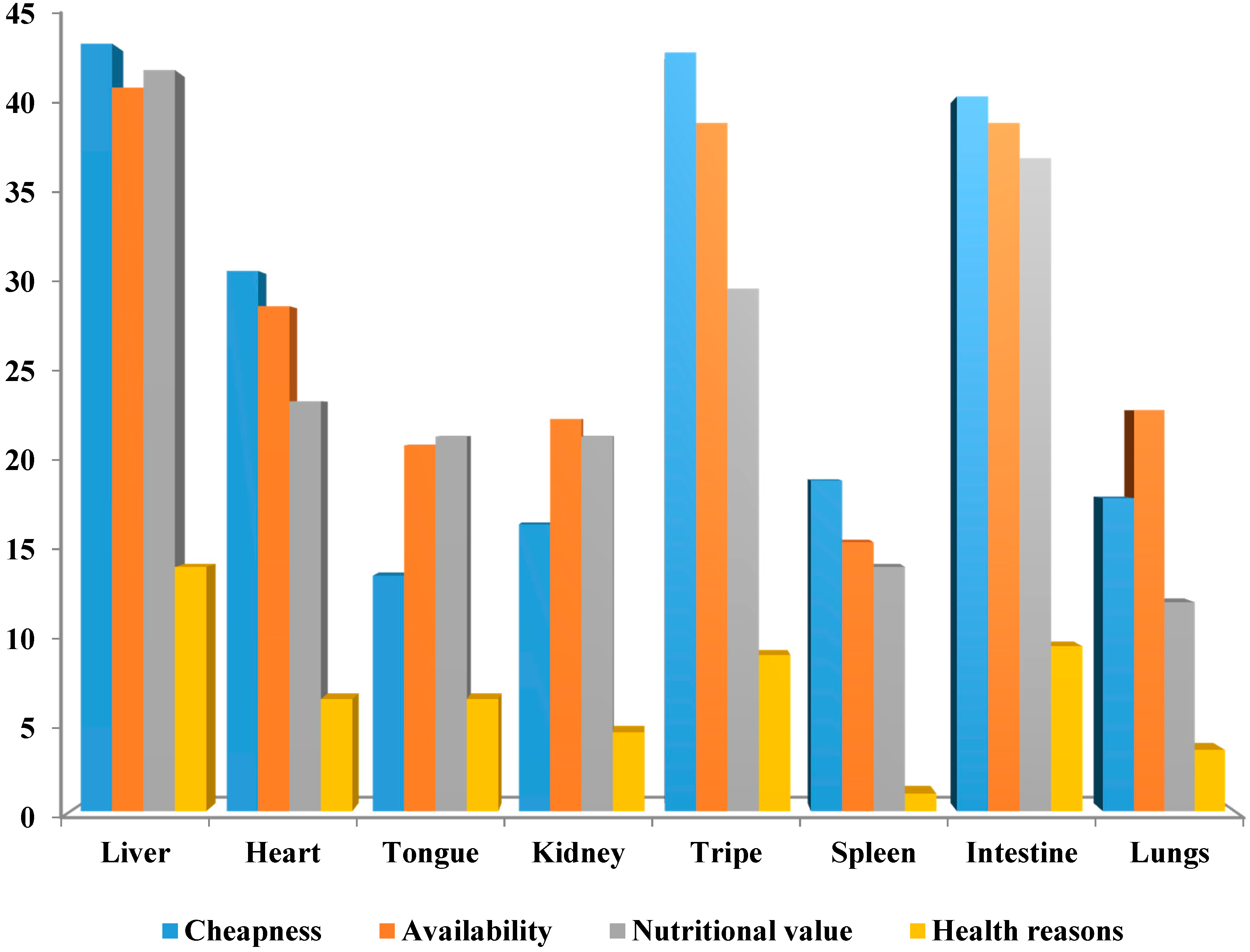Consumers’ Preference and Factors Influencing Offal Consumption in Amathole District Eastern Cape, South Africa
Abstract
1. Introduction
2. Materials and Methods
2.1. Study Site
2.2. Selection of Respondents
2.3. Data Collection
2.4. Statistical Analyses
3. Results and Discussion
3.1. Consumer Demography and Attributes
3.2. Attributes and Consumers’ Choice of Purchase-Point
4. Conclusions
Author Contributions
Funding
Acknowledgments
Conflicts of Interest
References
- Powell, D. Mad cow disease and the stigmatization of British beef. In Risk, Media, and Stigma: Understanding Public Challenges to Modern Science and Technology; Earthscan Publication Ltd.: London, UK; Sterling, VA, USA, 2001; pp. 219–228. [Google Scholar]
- Fox, J.A.; Peterson, H.H. Bovine Spongiform Encephalopathy (BSE): Risks and Implications for the United States. 2002. Available online: http://ageconsearch.umn.edu/bitstream/19061/1/cp02fo02.pdf (accessed on 17 June 2018).
- Selmane, D.; Christophe, V.; Gholamreza, D. Extraction of proteins from slaughterhouse by-products: Influence of operating conditions on functional properties. Meat Sci. 2008, 79, 640–647. [Google Scholar] [CrossRef] [PubMed]
- Alao, B.O.; Falowo, A.B.; Chulayo, A.; Muchenje, V. The potential of animal by-products in food systems: Production, prospects and challenges. Sustainability 2017, 9, 1089. [Google Scholar] [CrossRef]
- Fayemi, P.O.; Muchenje, V. Maternal slaughter at abattoirs: History, causes, cases and the meat industry. SpringerPlus 2013, 2, 125. [Google Scholar] [CrossRef] [PubMed]
- Xazela, N.M.; Hugo, A.; Marume, U.; Muchenje, V. Perceptions of Rural Consumers on the Aspects of Meat Quality and Health Implications Associated with Meat Consumption. Sustainability 2017, 9, 830. [Google Scholar] [CrossRef]
- Grunert, K.G.; Bredahl, L.; Brunsø, K. Consumer perception of meat quality and implications for product development in the meat sector—A review. Meat Sci. 2004, 66, 259–272. [Google Scholar] [CrossRef]
- Font-i-Furnols, M.; Luis, G. Consumer preference, behavior and perception about meat and meat products: An overview. Meat Sci. 2014, 98, 361–371. [Google Scholar] [CrossRef] [PubMed]
- Grunert, K.G. Food quality and safety: Consumer perception and demand. Eur. Rev. Agric. Econ. 2005, 32, 369–391. [Google Scholar] [CrossRef]
- Acebrón, L.B.; Domingo, C.D. The importance of intrinsic and extrinsic cues to expected and experienced quality: An empirical application for beef. Food Qual. Prefer. 2000, 11, 229–238. [Google Scholar] [CrossRef]
- Richardson, N.J. UK consumer perceptions of meat. Proc. Nutr. Soc. 1994, 53, 281–287. [Google Scholar] [CrossRef] [PubMed]
- Steenkamp, J.B.E.M.; van Trijp, H.C.M. Quality guidance: A consumer-based approach to food quality improvement using partial least squares. Eur. Rev. Agric Econ. 1996, 23, 195–215. [Google Scholar] [CrossRef]
- Bernués, A.; Ana, O.; Kate, C. Extrinsic attributes of red meat as indicators of quality in Europe: An application for market segmentation. Food Qual. Prefer. 2003, 14, 265–276. [Google Scholar] [CrossRef]
- Hoffmann, R. Country of origin—A consumer perception perspective of fresh meat. Br. Food J. 2000, 102, 211–229. [Google Scholar] [CrossRef]
- Steenkamp, J.-B.E.M. Conceptual model of the quality perception process. J. Bus. Res. 1990, 21, 309–333. [Google Scholar] [CrossRef]
- Henchion, M.; McCarthy, M.; Resconi, V.C.; Troy, D. Meat consumption: Trends and quality matters. Meat Sci. 2014, 98, 561–568. [Google Scholar] [CrossRef] [PubMed]
- Salleh, M.M.; Ali, S.M.; Harun, E.H.; Jalil, M.A.; Shaharudin, M.R. Consumer’s Perception and Purchase Intentions Towards Organic Food Products: Exploring Attitude Among Academician/La Perception Et L’intention De Rachat Des Consommateurs Envers Les Produits Alimentaires Biologiques: Études Sur L’attitude Des Universitaires. Can. Soc. Sci. 2010, 6, 119–129. [Google Scholar]
- Kardes, F.R.; John, K.; JeenSu, L. Consumer expertise and the perceived diagnosticity of inference. Adv. Consum. Res. 2001, 19, 409–410. [Google Scholar]
- Roberta, V.; Quester, P.; Karunaratna, A. The role of intrinsic (sensory) cues and the extrinsic cues of country of origin and price on food product evaluation. In Proceedings of the 3rd International Wine Business and Marketing Research Conference, Montpellier, France, 6–8 July 2006. [Google Scholar]
- Banović, M.; Klaus, G.; Grunert, M.; Madalena, B.; Magda, A.F. Beef quality perception at the point of purchase: A study from Portugal. Food Qual. Prefer. 2009, 20, 335–342. [Google Scholar] [CrossRef]
- Mancini, R.A. Meat color. In Improving the Sensory and Nutritional Quality of Fresh Meat; Kerry, J.R., Ledward, D., Eds.; CRC Press: Boca Raton, FL, USA; Woodhead Publishing Limited: Cambridge, UK, 2009; pp. 89–110. [Google Scholar]
- Gracia, A.; de-Magistris, T. Preferences for lamb meat: A choice experiment for Spanish consumers. Meat Sci. 2013, 95, 396–402. [Google Scholar] [CrossRef] [PubMed]
- Realini, C.E.; Kallas, Z.; Pérez-Juan, M.; Gómez, I.; Olleta, J.L.; Beriain, M.J.; Albertí, P.; Sañudo, C. Relative importance of cues underlying Spanish consumers’ beef choice and segmentation, and consumer liking of beef enriched with n-3 and CLA fatty acids. Food Qual. Prefer. 2014, 33, 74–85. [Google Scholar] [CrossRef]
- Chamhuri, N.; Peter, J.B. Exploring the factors influencing consumers’ choice of retail store when purchasing fresh meat in Malaysia. Int. Food Agribus. Manag. Rev. 2013, 16, 99–122. [Google Scholar]
- Labuschagne, A.; Louw, A.; Ndanga, L. A Consumer-Orientated Study of the South African Beef Value Chain. 2010. Available online: https://ageconsearch.umn.edu/bitstream/113788/2/199.%20Beef%20supply%20chain%20in%20South%20Africa.pdf (accessed on 5 March 2018).
- Prescott, J.; Young, O.; Zhang, S.; Cummings, T. Effects of added flavour principles on liking and familiarity of a sheepmeat product: A comparison of Singaporean and New Zealand consumers. Food Qual. Prefer. 2004, 15, 187–194. [Google Scholar] [CrossRef]
- Mannion, M.A.; Cowan, C.; Gannon, M. Factors associated with perceived quality influencing beef consumption behaviour in Ireland. Br. Food J. 2000, 102, 195–210. [Google Scholar] [CrossRef]
- Becker, T.; Benner, E.; Glitsch, K. Consumer perception of fresh meat quality in Germany. Br. Food J. 2000, 102, 246–266. [Google Scholar] [CrossRef]
- Troy, D.J.; Kerry, J.P. Consumer perception and the role of science in the meat industry. Meat Sci. 2010, 86, 214–226. [Google Scholar] [CrossRef] [PubMed]
- Rani, Z.T.; Hugo, A.; Muchenje, V. Perceptions of rural consumers on the quality of mutton in the Eastern Cape Province, South Africa. Sci. Res. Essays 2013, 21, 921–931. [Google Scholar]
- Integrated Development Plan (IDP). Amathole District Municipality IDP Review 2017–2016. Available online: www.amathole.gov.za/attachments/article/526/1617%20final%20idp.pdf (accessed on 7 September 2018).
- Russell, C.G.; Cox, D.N. Understanding middle-aged consumers’ perceptions of meat using repertory grid methodology. Food Qual. Prefer. 2004, 15, 317–329. [Google Scholar] [CrossRef]
- Verbeke, W.; Isabelle, V. Profile and effects of consumer involvement in fresh meat. Meat Sci. 2004, 67, 159–168. [Google Scholar] [CrossRef] [PubMed]
- Verbeke, W.; Ronald, W.W.; Jacques, V. Probit analysis of fresh meat consumption in Belgium: Exploring BSE and television communication impact. Agribusiness 2000, 16, 215–234. [Google Scholar] [CrossRef]
- Romano, D.; Stefani, G. The TRUST project: Summary of main findings. In How Safe is Eating Chicken? A Study on the Impact of Trust and Food Risk Communication on Consumer Behaviour in the European Union; Firenze University Press: Firenze, Italy, 2006; pp. 143–150. [Google Scholar]
- Walsh, C. The Use of Animal By-Products: The Improving Opportunities to Add Value to the Beef and Sheep Slaughtering Sectors. EBLEX, 2014; pp. 25–49. Available online: https://beefandlamb.ahdb.org.uk/wp-content/uploads/2016/07/74318-5th-Quarter-Use-and-Flow-Final-Report-130514.pdf (accessed on 23 March 2018).
- Ayroe, F.; Emikpe, B.O.; Asiamah, E.; Dankwa, K.O. Consumers’ preference and associated pathology observed in cattle and goat offals in Kumasi, Ghana. Afr. J. Infect. Dis. 2016, 10, 127–133. [Google Scholar]
- Nonterah, E.W.; Nyarko, T.A.; Emikpe, B.O.; Asare, D.A. Consumer preference for swine offals and its health implications in Kumasi, Ghana. Anim. Res. Int. 2016, 12, 2305–2310. [Google Scholar]
- De Andrade, J.C.; Nalério, E.S.; Giongo, C.; de Barcellos, M.D.; Ares, G.; Deliza, R. Consumer perception ofdry-cured sheep meat products: Influence of process parameters under different evoked contexts. Meat Sci. 2017, 130, 30–37. [Google Scholar] [CrossRef] [PubMed]
- Jabbar, M.A. Assessing Consumer Preferences for Quality and Safety Attributes of Food in the Absence of Official Standards: The Case of Beef in Ethiopia. In Proceedings of the International Association of Agricultural Economics Conference, Beijing, China, 16–22 August 2009; Available online: https://ageconsearch.umn.edu/bitstream/50120/2/IAAEpaperRef40.pdf (accessed on 7 August 2018).
- Liu, X.; Mack, K.N.; Mohammed, I. Analyzing Consumer’s Calculation Factors in the Purchase Decision of Goat Meat. J. Food Distrib. Res. 2007, 38, 196–202. [Google Scholar]




| Variable | Percentage | Frequency | |
|---|---|---|---|
| Gender | |||
| Female | 53.5 | 108 | |
| Male | 46.5 | 94 | |
| Household size | |||
| 0–5 | 75.8 | 153 | |
| 6–10 | 23.2 | 47 | |
| >10 | 1 | 2 | |
| Age | |||
| 15–24 | 11.4 | 23 | |
| 25–34 | 29.7 | 60 | |
| 35–44 | 27.2 | 55 | |
| 45–54 | 13.4 | 27 | |
| 55–64 | 11.9 | 24 | |
| 65–74 | 5.9 | 12 | |
| 75–84 | 0.5 | 1 | |
| Monthly Income | |||
| <R500 | 14.4 | 29 | |
| R501–R2000 | 56.4 | 114 | |
| R2001–R4000 | 12.9 | 26 | |
| R4001–R6000 | 6.9 | 14 | |
| R6001–R8000 | 2 | 4 | |
| R8001–R10,000 | 2 | 4 | |
| >R10,000 | 5.4 | 11 | |
| Educational Status | |||
| Grade 1–7 | 4.5 | 9 | |
| Grade 8–12 | 22.3 | 45 | |
| Matric | 46 | 93 | |
| Tertiary | 27.2 | 55 |
| Demography | Color | Leanness | Presence of Fat | Smell | Freshness | Flavor | Packaging | Price | Tenderness | Juiciness | Visual Display |
|---|---|---|---|---|---|---|---|---|---|---|---|
| Age | 0.227 | 0.292 | −0.660 | 0.310 | −0.231 | −0.899 | −0.029 * | 0.702 | −0.867 | −0.952 | 0.889 |
| Gender | 0.026 * | 0.668 | 0.474 | −0.392 | −0.820 | 0.750 | 0.012 * | 0.248 | 0.020 * | 0.031 * | −0.149 |
| Education | 0.876 | −0.175 | 0.102 | −0.03 * | −0.982 | −0.460 | 0.174 | 0.414 | 0.573 | 0.061 | 0.018 * |
| Income | 0.088 | −0.145 | 0.523 | −0.187 | −0.904 | −0.816 | 0.774 | 0.228 | −0.107 | 0.145 | 0.084 |
| H/Size | −0.397 | 0.865 | 0.029 * | 0.234 | −0.173 | −0.933 | −0.242 | −0.87 | −0.459 | 0.860 | 0.291 |
| Offal Type | Percentage | Frequency |
|---|---|---|
| Sheep | 41.1 | 83 |
| Cattle | 16.3 | 33 |
| Sheep and Cattle | 42.6 | 86 |
© 2018 by the authors. Licensee MDPI, Basel, Switzerland. This article is an open access article distributed under the terms and conditions of the Creative Commons Attribution (CC BY) license (http://creativecommons.org/licenses/by/4.0/).
Share and Cite
Alao, B.O.; Falowo, A.B.; Chulayo, A.; Muchenje, V. Consumers’ Preference and Factors Influencing Offal Consumption in Amathole District Eastern Cape, South Africa. Sustainability 2018, 10, 3323. https://doi.org/10.3390/su10093323
Alao BO, Falowo AB, Chulayo A, Muchenje V. Consumers’ Preference and Factors Influencing Offal Consumption in Amathole District Eastern Cape, South Africa. Sustainability. 2018; 10(9):3323. https://doi.org/10.3390/su10093323
Chicago/Turabian StyleAlao, Babatunde Oluwasegun, Andrew Bamidele Falowo, Amanda Chulayo, and Voster Muchenje. 2018. "Consumers’ Preference and Factors Influencing Offal Consumption in Amathole District Eastern Cape, South Africa" Sustainability 10, no. 9: 3323. https://doi.org/10.3390/su10093323
APA StyleAlao, B. O., Falowo, A. B., Chulayo, A., & Muchenje, V. (2018). Consumers’ Preference and Factors Influencing Offal Consumption in Amathole District Eastern Cape, South Africa. Sustainability, 10(9), 3323. https://doi.org/10.3390/su10093323





